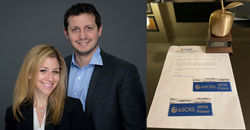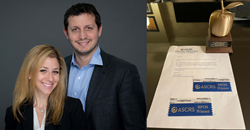
Eric Rosenberg, D.O. and Alanna Nattis, D.O., from Babylon, NY won highly competitive awards at 2021 ASCRS Meeting
“It’s very rewarding that our research department is putting out world class research that competes on the national and international stage—but not just with other private practices but large-scale academic practices.” -Dr. Eric Rosenberg
HAUPPAGUE, N.Y. (PRWEB)
August 27, 2021
Two Long Island-based SightMD ophthalmologists were participants and award winners at the 2021 American Society of Cataract and Refractive Surgery (ASCRS) Annual Meeting, which took place in July in Las Vegas, NV.
Husband and wife, Eric Rosenberg, D.O. and Alanna Nattis, D.O., from Babylon, participated in several events at the conference. They served as instructors and also moderated panel discussions. Most notable were their presentations of papers on “Intracanalicular Dexamethasone Insert for Post-Corneal Crosslinking Inflammation and Pain,” which were awarded for “Best Paper in Session” and “Best of the Best Paper.” Additionally, Dr. Rosenberg won the “Best Teaching Case in Complicated and Challenging Cases” award.
The ASCRS meeting is considered to be among the most important annual national and international conferences for anterior segment, glaucoma, and cataract surgeons, with a focus on developing technologies and notable scientific advancements.
“It was nice to be able to do an in-person conference again after last year, when the pandemic shut everything down,” said Dr. Rosenberg. “There were a lot of novel and new things presented at this conference, because it’s been two years’ worth of research and advancement that have taken place and it was nice to be engrossed in that atmosphere of learning about developing technology to provide the best for our patients.”
Being selected to present at the ASCRS is a highly selective process and one that is considered an honor. SightMD had two scientific films, one electronic poster presentation and eight research studies accepted for presentation, two of which went on to win awards for “Best of Session” and “Best Overall Paper.”
“Every year, thousands of doctors submit proposals on research items that they’re working on, and only a handful of those doctors are asked to stand at the podium and present their research.” Dr. Rosenberg said. “It’s very rewarding that our research department is putting out world class research that competes on the national and international stage—but not just with other private practices but large-scale academic practices. These are people who have million dollar-funded research departments, and we’re winning awards right next to them.”
Dr. Alanna Nattis is Director of Research at SightMD and was responsible for half the papers that were submitted to the ASCRS this year, including the “Best of the Best Paper”. She says it was amazing to have such a notable presence among other academic presenters at this year’s ASCRS meeting considering the level of competition.
“I’m incredibly proud of the work being recognized at ASCRS,” Dr. Nattis said. “We’ve been able to build upon the studies we’ve been doing at SightMD, and several of them were highlighted and chosen among thousands of other submissions. We’re continuing to grow as a department, and we had a major presence at the ASCRS, and I think that says a lot for our practice and the research department…. A lot of major universities show up to this meeting and they’re the ones that dominate, but we had a significant presence there so that’s something that I’m really proud of.”
The Awards
The first paper to win “Best of Session” (awarded for best podium presentation given for that subset of papers, one award per 15-20 presentations), was entitled “What’s Light Got to Do With It?” which focused on SightMD’s NGENUITY 3-D digital visualization project. This study compared the light intensity percentage and light exposure time of coaxial illumination in routine cataract surgery using a 3-D digital visualization system (NGENUITY) versus a conventional surgical operating microscope.
“SightMD was the second in the state of New York to adopt this technology, and it allows us to visualize cataract surgery on a 55′ OLED 3-D TV in the operating room, so we’re no longer coupled to the binoculars that we used for cataract surgery,” Rosenberg explained. “Now we can operate with the large TV and under a high level of magnification and a high level of detail like we’ve never been able to see before. That project (detailed in the paper) looked at the total light intensity that I used while doing the cataract surgery. I found that I can use significantly less light because the computer that’s attached to the TV up gains the amount of light intensity—meaning that my patients do better post-operative day one in terms of vision. They come back to their best-corrected vision almost immediately after surgery, in addition to using less light at the time of cataract surgery. Light can be toxic for the retina, so the less light we use during surgery, the better it is for our patients.”
The second paper to win, entitled “Demodex for the Rest of Us,” went on to win “Best of Session” as well as “Best of the Best.” This paper focused on the analysis of eyelashes from two large medical tertiary centers to determine the prevalence of demodex (a small mite that lives in skin and can potentially cause blepharitis, eye irritation, and dry eye symptoms) in the regular population.
“It’s something that ophthalmologists never really looked at before now,” Rosenberg said. “We’re showing that there is pretty high prevalence of it, and we should be looking for it to treat our patients. We found that demodex can be present in up to 70 percent of patients that present to us with blepharitis. With this particular paper, we published an algorithm on the likelihood of a patient having demodex based on a wide range of factors.”
The 2021 ASCRS Annual Meeting—”Best Teaching Case in Complicated and Challenging Cases”—was based on a video, “Traumatic Cataract: Cataract Extraction with Intraocular Lens Implantation + the “In-N-Out” Procedure”, that Dr. Rosenberg submitted about a new technique called the “In-N-Out” procedure he invented to treat iridodialysis by repairing the iris.
“There is only one of these awards per meeting, and it is one of the most coveted awards of the meeting,” Dr. Rosenberg explains. “The conference has a symposium that’s for complex cataract surgery. Videos from all over the world are submitted for that symposium, and only six videos are selected to be presented on the main stage during the meeting. World-renowned experts evaluate and select only one of those six videos as the best in complex cataract teaching cases.”
About the Ophthalmologists
Dr. Eric Rosenberg specializes in advanced corneal transplant techniques and procedures (including DMEK and crosslinking), traditional and laser-assisted cataract surgery, laser vision correction, and complex anterior segment surgery. Dr. Rosenberg is currently seeing patients in Babylon, West Islip, and Plainview, NY.
Dr. Alanna Nattis specializes in cornea, cataract and refractive surgery and is the Director of Clinical Research for SightMD. Dr. Nattis is also a Clinical Assistant Professor in Ophthalmology and Surgery at NYIT College of Osteopathic Medicine. Dr. Nattis is currently seeing patients in Babylon and Amityville, NY.

